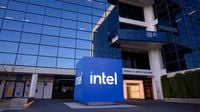On August 19, 2025, the landscape of the global semiconductor industry shifted dramatically as the Trump administration confirmed its plans to take a significant stake in Intel Corp., the iconic American chipmaker. This move, which would see the federal government convert grants from the US Chips and Science Act into equity, has the potential to make the United States the largest shareholder in Intel—a company long considered a bellwether of American technological might. The announcement came on the heels of a surprise $2 billion investment in Intel by Japan’s SoftBank Group, signaling renewed international confidence in the company’s future.
Commerce Secretary Howard Lutnick, speaking to CNBC, was unequivocal about the administration’s intentions. “It’s not governance, we’re just converting what was a grant under Biden into equity,” Lutnick stated, stressing that the stake would be non-voting and would not confer governance rights on the US government, despite the possibility of becoming Intel’s largest shareholder. The plan, Lutnick explained, is to deliver money already committed under the Biden administration but to demand equity in return for it. “Why are we giving a company worth $100 billion this kind of money? What is in it for the American taxpayer? And the answer Donald Trump has is we should get an equity stake for our money,” Lutnick added, according to Bloomberg.
The numbers behind the move are as striking as the policy shift itself. Intel is slated to receive a combined $10.9 billion in grants for both commercial and military production under the Chips and Science Act, with access to up to $11 billion in loans from the same law enacted in 2022. At Intel’s current market value, a 10% stake would be worth roughly $10.5 billion, making the US government by far the chipmaker’s largest shareholder if the plan goes through. The exact size of the stake and whether the White House will proceed remains in flux, but the intent is clear: taxpayer dollars should yield tangible returns, not just subsidies.
This approach marks a sharp departure from the previous administration’s policy, which, Lutnick argued, provided subsidies to semiconductor manufacturers without securing any direct benefits for American taxpayers. “Imagine this: the Biden administration was literally giving Intel — for free, and giving TSMC money for free and all these companies just giving them money for free,” Lutnick said, referencing Taiwan Semiconductor Manufacturing Co. “Donald Trump turns that into saying, ‘Hey, we want equity for the money.’ How could that not be smarter, better and more important for the American taxpayer than just free money?”
While the Trump administration’s plan has yet to be formalized, the news has already sent ripples through the markets and the semiconductor industry at large. Intel shares surged by as much as 11% during New York trading on Tuesday, while SoftBank’s stock dropped 4% in Tokyo, reflecting the divergent fortunes of the two companies as they bet on Intel’s turnaround. SoftBank, for its part, announced it would purchase $2 billion worth of newly issued Intel common stock at $23 per share, amounting to an approximate 2% stake in the company. This investment represents a vote of confidence from SoftBank founder Masayoshi Son, who is eager to capitalize on the booming artificial intelligence (AI) sector and sees Intel’s chip design capabilities as a potential goldmine.
Intel CEO Lip-Bu Tan welcomed SoftBank’s investment, noting his longstanding relationship with Son and expressing gratitude for the show of faith. “I appreciate the confidence he has placed in Intel with this investment,” Tan said, according to reporting from Bloomberg. The SoftBank deal is subject to customary closing conditions, but it underscores a broader push by the Japanese conglomerate to tap into the surging demand for AI-related hardware and services.
For the US government, however, the motivations are more complex and rooted in national security concerns. Lutnick emphasized the importance of reshoring chip manufacturing to reduce America’s reliance on foreign suppliers, particularly those in Taiwan, which sits at the center of geopolitical tensions. “We need to make our own chips here. We cannot rely on Taiwan,” Lutnick asserted, underscoring the strategic imperative behind the administration’s policy shift.
The potential government stake in Intel could also set a precedent for future dealings with other chipmakers. If finalized, the arrangement would represent a sea change in US semiconductor policy, laying the groundwork for similar agreements that tie public funding directly to equity stakes—effectively ensuring taxpayers share in the upside of America’s technological resurgence. “The discussions underway with Intel would mark a sea change in US policy toward semiconductors,” Bloomberg reported, highlighting the broader implications for the industry.
Political reactions to the plan have been mixed, reflecting the deep divisions over industrial policy and government intervention in the private sector. Supporters of the Trump administration’s approach argue that it is only fair for taxpayers to receive a return on their investment, especially given the strategic importance of semiconductors in everything from consumer electronics to military hardware. Critics, however, warn that government ownership—even in a non-voting capacity—could set a dangerous precedent and potentially stifle innovation or distort market competition.
Adding another layer of intrigue, the news comes less than two weeks after former President Trump called for the resignation of Intel CEO Lip-Bu Tan, following a letter from Republican Senator Tom Cotton raising concerns about Tan’s business ties to China and a recent criminal case involving his former firm, Cadence Design. While the administration has not directly linked the equity plan to these concerns, the timing has fueled speculation about the broader strategic calculus at play.
Meanwhile, the Trump administration has signaled an openness to allowing Nvidia Corp. to sell a new, scaled-back AI chip to China, provided certain conditions are met. Lutnick noted that the administration had already negotiated a deal with Nvidia and Advanced Micro Devices Inc. that would see the government receive 15% of revenue from Chinese chip sales. “Of course, he would like to sell a new chip to China,” Lutnick said of Nvidia’s CEO Jensen Huang. “I’ve listened to him pitch the president, and the president listens to our great technology companies, and he’ll decide how he wants to play.”
As the world watches, Intel’s future—and the future of American semiconductor policy—hangs in the balance. With billions of dollars at stake and the promise of technological self-sufficiency on the line, the coming months will reveal whether the Trump administration’s bold gamble pays off, not just for Intel, but for the American taxpayer as well.



